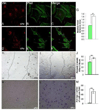Embryonic domains of the aorta derived from diverse origins exhibit distinct properties that converge into a common phenotype in the adult
- PMID: 24508561
- PMCID: PMC4034360
- DOI: 10.1016/j.yjmcc.2014.01.016
Embryonic domains of the aorta derived from diverse origins exhibit distinct properties that converge into a common phenotype in the adult
Abstract
Vascular smooth muscle cells (VSMCs) are derived from distinct embryonic origins. Vessels originating from differing smooth muscle cell populations have distinct vascular and pathological properties involving calcification, atherosclerosis, and structural defects such as aneurysm and coarctation. We hypothesized that domains within a single vessel, such as the aorta, vary in phenotype based on embryonic origin. Gene profiling and myographic analyses demonstrated that embryonic ascending and descending aortic domains exhibited distinct phenotypes. In vitro analyses demonstrated that VSMCs from each region were dissimilar in terms of cytoskeletal and migratory properties, and retention of different gene expression patterns. Using the same analysis, we found that these same two domains are indistinguishable in the adult vessel. Our data demonstrate that VSMCs from different embryonic origins are functionally distinct in the embryonic mouse, but converge to assume a common phenotype in the aorta of healthy adults. These findings have fundamental implications for aortic development, function and disease progression.
Keywords: Mesoderm; Neural crest; Smooth muscle; Vasculature.
Copyright © 2014 Elsevier Ltd. All rights reserved.
Figures






References
-
- Katora ME, Hollis TM. Regional variation in rat aortic endothelial surface morphology: relationship to regional aortic permeability. Exp Mol Pathol. 1976;24:23–34. - PubMed
-
- Gadson PF, Jr, Rossignol C, McCoy J, Rosenquist TH. Expression of elastin, smooth muscle alpha-actin, and c-jun as a function of the embryonic lineage of vascular smooth muscle cells. In Vitro Cell Dev Biol Anim. 1993;29A:773–781. - PubMed
-
- Ruckman JL, Luvalle PA, Hill KE, Giro MG, Davidson JM. Phenotypic stability and variation in cells of the porcine aorta: collagen and elastin production. Matrix Biol. 1994;14:135–145. - PubMed
-
- Stenmark KR, Mecham RP. Cellular and molecular mechanisms of pulmonary vascular remodeling. Annu Rev Physiol. 1997;59:89–144. - PubMed
Publication types
MeSH terms
Substances
Grants and funding
LinkOut - more resources
Full Text Sources
Other Literature Sources
Molecular Biology Databases

